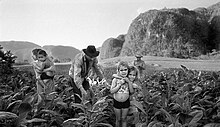Social documentary photography
Social documentary photography or concerned photography is the recording of what the world looks like, with a social and/or environmental focus. It is a form of documentary photography, with the aim to draw the public's attention to ongoing social issues. It may also refer to a socially critical genre of photography dedicated to showing the life of underprivileged or disadvantaged people.
Origin of social documentary photography

Social documentary photography has its roots in the 19th-century work of Henry Mayhew, Jacob Riis, and Lewis Hine, but began to take further form through the photographic practice of the Farm Security Administration (FSA) in the USA. The FSA hired photographers and writers to report and document the plight of poor farmers. Under Roy Stryker, the Information Division of the FSA adopted a goal of "introducing America to Americans." Many noted Depression-era photographers were fostered by the FSA project, including Walker Evans, Dorothea Lange, and Gordon Parks. The photographers documented the situation of poor farmers, whose economic existence was threatened, and created a new style with photographic documentation of social problems.
FSA made 250,000 images of rural poverty, but only about half survive. These are now housed in the Prints and Photographs Division of the Library of Congress and online.[1] From these some 77,000 different finished photographic prints were originally made for the press, plus 644 color images from 1,600 color negatives.
Characteristics of social documentary photography
Social documentary photography or concerned photography may often be devoted to 'social groups' with socio-economic and cultural similarities, showing living or working conditions perceived as shameful, discriminatory, unjust or harmful. Examples include child labor, child neglect, homelessness, poverty among segments of society, impoverished children and the elderly, and hazardous working conditions. The poor, the social outcasts, or lower classes are portrayed in compassionate observation. The documentary power of the images is associated with the desire for political and social change.
History
As early as in the 19th century the living conditions for the lower classes were the subject of photography. Henry Mayhew photographed the book London Labour and the London Poor, a representation of the depiction of London's working class.[2] The book was illustrated by woodcuts, from photographs by Beard. Thomas Annan published "Photographs of the Old Closes and Streets of Glasgow, 1868-77", a documentation of the slum areas in Glasgow. Yet another example is the book published by Smith and Thompson in 1877 "Street Life in London", which also documented social life. England was the birthplace of social documentary photography, given the advanced stage of industrialization, and its impact on society.
An English pioneer of socially committed photography is
After 1945 the dedicated, collectively organized social documentary photography no longer was able to gain ground, except in England, where the tradition lingered on a bit longer. The vigorous anti-communism of the McCarthy era had anathematized the engaged, liberal social documentary photography with the verdict of evil. Great documentary photographers of the postwar era, such as
British photojournalist Don McCullin specialised in examining the underside of society, and his photographs have depicted the unemployed, downtrodden and the impoverished. He is also recognised for his war photography and images of urban strife.
A social documentary photographer of the present is Brazilian photographer Sebastião Salgado, who has documented the industrial age (Workers: An Archaeology of the Industrial Age, 1993). Another central theme of his work is the global phenomenon of migration (The Children: Refugees and Migrant (2000) and Migrations (2000)). In both documentaries he demonstrated the plight of refugees in many countries around the world.
The documentary photography of Martin Parr contrasts starkly with that of Salgado, at times being humorous.

The aims of social documentation continue today in Puerto Rican photographer Manuel Rivera-Ortiz's photographs of lives in poverty.[5] Affected by his own experience of growing up poor in rural Puerto Rico, Rivera-Ortiz refers to his work as a celebration of life, in poverty.[6]
Acceptance by the art world
Since the late 1970s, social documentary photography has increasingly been accorded a place in art galleries alongside
Some photographers address social issues without dedicated advocacy for the victims of social inequality and grievance, such as Diane Arbus or
Footnotes
- ^ 164,000 FSA photographs, Library of Congress
- ISBN 0-14-043241-8
- ^ "History of NCLC". National Child Labor Committee. Archived from the original on 21 June 2008. Retrieved 25 November 2008.
- )
- ^ Korzun, Kelly (24 November 2015). "Book Review: India A Celebration of Life by Manuel Rivera-Ortiz". Musée Magazine. Archived from the original on 8 December 2015. Retrieved 28 November 2015.
- ^ Puri, Nikita (12 November 2015). "A photographer shares his frames from the fringes". Business Standard. Retrieved 25 November 2015.
- ^ Malo, Alejandro. "Documentary Art". ZoneZero. Retrieved 13 December 2010.
- ISBN 0-7139-1635-4
Further reading
- London Labour and the London Poor; selections made and introduced by ISBN 0-14-043241-8
- Geoffrey Dunn, "Untitled Depression Documentary", 1980
- ISBN 0-8174-0316-7(0-8174-0316-7)
- The New Documentary Tradition in Photography (Lisa Hostetler, The Metropolitan Museum of Art)
